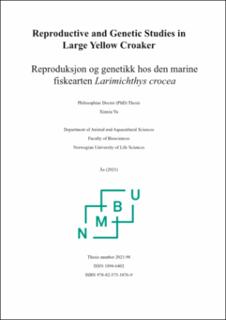| dc.description.abstract | Large yellow croaker (Larimichthys crocea) is distributed in the coastal regions of East Asia and is one of the most important marine aquaculture species in China. However, due to overfishing, it has been difficult to capture wild fish for the last decades. Artificial reproduction and aquaculture of it has been performed since 1985 in China, but important production traits have been deteriorating due to poor broodstock practices. It is thus considered necessary to initiate a modern breeding programme to improve these traits through an efficient selection programme, and the facilitations of this thus became the aim of this PhD project. In paper I, two trials with artificial fertilisation in large yellow croaker were tested and compared. Results show that double injections of LHRH A3 (dosage 0.8 μg/kg and 2 μg/kg ) in females with an interval of 10 h, and single injection (dosage 1μg/kg) in males gave highest fertilisation and hatching percentage. The best latency time (a time period between first hormone injection and spawning) was 29.5-35 h, which were determined by only monitoring courtship behaviour of males to reduce stress. Compared to the initial trial, the percentage of females with spawning difficulties decreased from 30% to 10%, while the fertilisation rate and hatching rate increased from 28% to 41% and from 52% to 62%, respectively. The new protocol of artificial fertilisation will be useful in family construction of future breeding programmes. In paper II, phenotypic and genetic parameters were estimated for body weight, body length and body height in six months old large yellow croaker. The trial was planned to run until the fish had reached a normal harvest size, but due to severe damages to the test facility during a typhon, the trial had to be ended prematurely. The records used for parameter estimation thus are from when the fish were tagged, at an age of only 6 months. The estimates of heritability, which ranged from 0.31±0.06 to 0.41±0.07, may thus be influenced also by common environmental effects unique to each family prior to tagging. The three traits recorded were closely correlated, both genetically and phenotypically, with all genetic correlations above 0.74 and phenotypic correlations above 0.84. These results thus clearly indicate good prospects for efficient selection for BW, BL and BH in large yellow croaker. XII In paper III, a high-density genetic linkage map was constructed using a family from a cross of the Mindong and Daiqu strains. A total of 20,147 single nucleotide polymorphisms (SNPs) markers were assigned to 24 linkage groups (LGs). The length of the consensus linkage map was 1757.4 cM, with individual LGs ranging from 51.9cM (LG6) to 124.6cM (LG9). Sex-specific maps were also constructed, and recombination events occurred 20% more frequently in females. Collapsed or co-occurring markers in the genetic maps were re ordered according to their relative positions in the ASM435267v1 genome assembly to produce integrated linkage maps, resulting in 9,885 SNPs distributed across the 24 LGs. The recombination patterns of most LGs were sigmoidal, with higher recombination rates in the middle and suppressed recombination rates at the ends, consistent with sub-telocentric and acrocentric chromosomes, respectively. The average recombination rate in the integrated female and male maps was respectively 3.55 cM/Mb and 3.05 cM/Mb, as recombination rates in the females were higher than in the males for most LGs. No significant quantitative trait loci (QTL) for growth traits at six months were detected in the QTL or association analyses. The study indicates there may be genetic differences between the Daiqu strain and Mindong strain that can be important for application of genetic tools in a mixed breeding population. | en_US |

